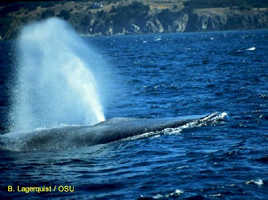| Whale Biology-blue whale | ||||
|
|
||||
|
Blue
Whale
Balaenoptera musculus {Federally endangered species} |
 |
|||
|
Blue whales are planktivorous, feeding on dense patches of krill, often lunging or rolling at the surface when consuming their prey. The gestation period is about 12 months, and females calve every 2-3 years. Calves are 7-8 m in length and can weigh up to 3.6 MT. Three subspecies have been described to date: B.m. intermedia, from the southern hemisphere, B.m. musculus, from the northern hemisphere Atlantic and Pacific oceans, and B.m. brevicauda, the pygmy blue whale (Yochem and Leatherwood 1985). The north Pacific blue whale population is estimated to number between 1400-2000 individuals (Mizroch et al. 1984, Yochem and Leatherwood 1985, Barlow 1994). Recent studies indicate the number of animals found along the coast of central California appears to be increasing (Calambokidis et al. 1990, Barlow 1994. |
||||

There's nothing here-the left column is really the main content
 The
blue whale, Balaenoptera musculus, is the largest
of all the cetaceans, averaging 26 m in length and weighing
up to 136 MT. The body is bluish gray in color and often mottled
with white spots. The dorsal fin is quite small (<30 cm)
and is located further down the back than in other whale species
(Leatherwood et al. 1976).
The
blue whale, Balaenoptera musculus, is the largest
of all the cetaceans, averaging 26 m in length and weighing
up to 136 MT. The body is bluish gray in color and often mottled
with white spots. The dorsal fin is quite small (<30 cm)
and is located further down the back than in other whale species
(Leatherwood et al. 1976).